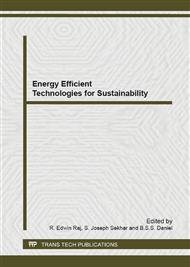[1]
Sunil Chamoli, Ranchan Chauhan, NS. Takur, JS. Saini, A review of the performance of double pass solar air heater, Renewable and Sustainable Energy Reviews 2010; 16: 481 – 492.
DOI: 10.1016/j.rser.2011.08.012
Google Scholar
[2]
Rene Tcinda, A review of the mathematical models for predicting solar air heater systems; Renewable and Sustainable Energy Reviews 2009; 13; 1734 – 59.
DOI: 10.1016/j.rser.2009.01.008
Google Scholar
[3]
K. Branker, JM. Pearce, Financial return for government support of large scale thin film solar photovoltaic manufacturing in Canada, Energy Policy 2010; 38: 4291 – 303.
DOI: 10.1016/j.enpol.2010.03.058
Google Scholar
[4]
M. Thirugnanasambandam, S. Iniyan, R. Goic. A review of solar thermal technologies. Renew Sust Energy Rev 2010; 14(3); 312 – 22.
DOI: 10.1016/j.rser.2009.07.014
Google Scholar
[5]
B. Sandnes, J. Rekstad. A photovoltaic/thermal (PV/T) collector with a polymer absorber plate: experimental study and analytic model. Sol Energy 2002; 72(1): 63–73.
DOI: 10.1016/s0038-092x(01)00091-3
Google Scholar
[6]
MR. Patel,. Wind and Solar Power Systems 2006. Taylor and Francis group, 447.
Google Scholar
[7]
JK. Tonui, Y. Tripanagnostopoulos. Renewable Energy 2007; 32; 623 – 37.
Google Scholar
[8]
F. Sarhaddi, S. Farahat, H. Ajam, A. Behzadmehr. Exergetic performance assessment of a solar photovoltaic thermal (PV/T) air collector. Energy and Buildings 2010; 42; 2184 – 2199.
DOI: 10.1016/j.enbuild.2010.07.011
Google Scholar
[9]
G. Xu, S. Deng, X. Zhang, L. Yang, Y. Zhang. Simulation of a Photovoltaic/Thermal Heat Pump System Having a Modified Collector/Evaporator. Sol. Energy 2009, 83: 1967-(1976).
DOI: 10.1016/j.solener.2009.07.008
Google Scholar
[10]
A. Shahsavar, M. Ameri. Experimental investigation and modeling of a direct-coupled Experimental investigation and modeling of a direct-coupled PV/T air collector; Solar Energy 2010; 84; 1938-58.
DOI: 10.1016/j.solener.2010.07.010
Google Scholar
[11]
HA. Zondag, DW. De Vries, WGJ. Van Helden, RJC van Zolingen, AA Van Steenhoven. The thermal and electrical yield of a PV – thermal collector. Solar Energy 2002; 72(2): 113 -28.
DOI: 10.1016/s0038-092x(01)00094-9
Google Scholar
[12]
H. Mortezapour, B. Ghobadian, M.H. Khoshtaghaza, S. Minaei. Performance Analysis of a Two-way Hybrid Photovoltaic/Thermal Solar Collector, Journal of Agr. Sci. Tech. 2012; 14; 767 – 80.
Google Scholar
[13]
Rakesh Kumar, Marc A. Rosen. A critical review of photovoltaic – thermal solar collectors for air heating. Applied Energy 2011; 88: 3603 – 3614.
DOI: 10.1016/j.apenergy.2011.04.044
Google Scholar
[14]
Skoplaki, JA. Palyros. On the temperature difference of photovoltaic module electrical performance: A review of efficiency/power correlations. Solar Energy 2009; 83: 614 – 24.
DOI: 10.1016/j.solener.2008.10.008
Google Scholar
[15]
AK. Agarwal, HP. Garg. Study of a photovoltaic-thermal system – thermosyphonic solar water heater combined with solar cells. Energy Convers Manage 1994; 35(7); 605 – 20.
DOI: 10.1016/0196-8904(94)90044-2
Google Scholar
[16]
JA. Duffie, WA. Beckman. Solar Engineering of Thermal Processes, John Wiley & Sons, New York, (1980).
Google Scholar
[17]
GN. Tiwari. Solar Energy Fundamentals, Design, Modeling and Applications, New Delhi, Narosa Publishing House; (2004).
Google Scholar
[18]
SP. Sukhatme. Solar Energy. Mc Graw Hill; (1993).
Google Scholar
[19]
Chow TT. Performance analysis of photovoltaic-thermal collector by explicit dynamic model. Sol Energy 2003; 75: 143–52.
DOI: 10.1016/j.solener.2003.07.001
Google Scholar
[20]
GN. Tiwari, MK. Ghosal. Renewable energy resources, basic principle and applications. Middlesex: Alpha Science International; (2005).
Google Scholar
[21]
MA. Karim, MNA. Hawlader. Development of solar air collectors for drying applications; Energy Conversion and Management 2004; 45; 329-44.
DOI: 10.1016/s0196-8904(03)00158-4
Google Scholar
[22]
SP. Sukhatme, Solar Energy. Tata McGraw –Hill Publishing Company (1984).
Google Scholar
[23]
Adel A. Hegazy. Comparative study of the performances of four photovoltaic / thermal solar air collectors. Energy Convers Manage 2000; 41: 861 – 81.
DOI: 10.1016/s0196-8904(99)00136-3
Google Scholar
[24]
S Satcunanathan, D. Deonaraine. A two pass solar air-heater. Solar Energy 1973; 15(1): 41–49.
DOI: 10.1016/0038-092x(73)90004-2
Google Scholar
[25]
Anand S. Joshi, Arvind Tiwari. Energy and exergy efficiencies of a hybrid photovoltaic–thermal (PV/T) air collector. Renewable Energy 2007; 32; 2223-41.
DOI: 10.1016/j.renene.2006.11.013
Google Scholar
[26]
Arvind Tiwari, M.S. Sodha. Parametric study of various configurations of hybrid PV/thermal air collector: Experimental validation of theoretical model. Solar Energy Materials and Solar Cells 2007; 91; 17 – 28.
DOI: 10.1016/j.solmat.2006.06.061
Google Scholar
[27]
SA. Kalogirou, Y. Tripanagnostopoulos. Industrial application of PV/T solar energy systems. Applied Thermal Engineering 2007; 27: 1259–70.
DOI: 10.1016/j.applthermaleng.2006.11.003
Google Scholar
[28]
Y. Tripanagnostopoulos, ThM. Souliotis, P. Yianoulis. Hybrid photovoltaic/thermal solar systems. Solar Energy 2002; 72: 217–34.
DOI: 10.1016/s0038-092x(01)00096-2
Google Scholar
[29]
HA. Zondag, DW. De Vries, WGJ. Van Helden, RJC van Zolingen, AA Van Steenhoven. The thermal and electrical yield of a PV – thermal collector. Solar Energy 2002; 12; 415 – 26.
DOI: 10.1016/s0038-092x(01)00094-9
Google Scholar
[30]
Solar Wall, PV/T solar air heating and electricityhttp: /solarwall. com/media/images-main/ 2-products/brochure/Solar Wall PVT_Spec. pdf.
Google Scholar
[31]
M. Taki Al-Kamil, AA. Al-Ghareeb. Effect of thermal radiation inside solar air heaters; Energy Convers. Mgmt. 1997; Vol. 38; No. 14; 1451-58.
DOI: 10.1016/s0196-8904(96)00050-7
Google Scholar
[32]
KGT. Hollands, TE. Unn, GR. Raithby, L. Konicek. Free convection heat transfer across inclined air layers. Transactions of ASME Journal of Heat Transfer 1976; 98: 189 – 93.
DOI: 10.1115/1.3450517
Google Scholar
[33]
AJ. Huang, TH. Lin, WC. Hung, FS. Sun. Performance evaluation of solar photovoltaic/thermal systems. Solar Energy 2001; 70(5): 443-8.
DOI: 10.1016/s0038-092x(00)00153-5
Google Scholar
[34]
I. Adnan, K. Sopian, MJ. Othman, MH. Ruslan. Proceedings of the World Renewable Energy Congress X, Glasgow; Scotland; 19 – 25; July (2008).
Google Scholar



